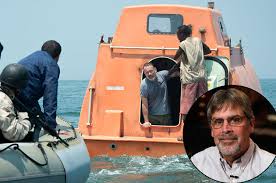‘Captain Phillips’: A Review
I recommend that you see the new film “Captain Phillips” about a cargo ship hijacked by four young men from Somalia in 2009. The plain facts erupt on screen in a gripping story about power, violence, and the struggle to survive. Actor Tom Hanks gives an unforgettable performance as Richard Phillips of Vermont, captain of the merchant vessel Maersk Alabama, a U.S.-flagged ship the size of a large building if laid on its side. I remember hearing about this incident off the east coast of Africa in the spring of 2009, particularly the astounding outcome with Navy SEAL snipers killing three of Phillips’ captors in the climax of the confrontation.The rescue of Phillips is seen as a brilliant operation executed with precision; we would see this again in the take down of Bin Laden in Pakistan. But the news reports did not convey the complex story behind the story. The film does that. The initial encounter with the young men, referred to as pirates, is a shocking display of asymmetrical battle. Four raggedy young guys with automatic weapons and a fast small boat take down the behemoth cargo carrier whose crew of about 20 men is armed with nothing but water hoses, flares, and hand tools. It was like a leopard bringing down a water buffalo. In our hyper-security conscious society, how is it that the huge cargo ships went to sea without armed private security guards? There wasn’t a gun on the ship, even after the Somalis had been hijacking merchant vessels regularly. Fortunately, US military assets were in the general area. That aside, the combined arrogance, anger, and courage of the Somalis, some of them in their teens, offers a window into the contest we Americans have been engaged in with raging enemies for the past few decades. Call it hijacking or piracy, but the tactics were designed to terrorize the victims: surprise attack, threats to kill, demands for ransom money, hostage-taking, beatings and psychological abuse. When Phillips asks one of his captors, “There must be something else you can do than this to survive?,” the young man says, “Maybe in America”—but not where he comes from.
Even though the viewer knows the outcome of this story, Hanks’s performance demands every second of attention. The young actors from Minneapolis, Minn., where there is a large Somali community, don’t give up an ounce of intensity to Hanks, especially Barkhad Abdi, who plays the leader of the hijacking crew. Hanks gives expression to the trauma experienced by the captain, but there is a sense of something larger going on.
If a viewer pulls way back from the story on screen, it is possible to see Phillips as a stand in for the American people as a whole since the turn of this 21st century. We are not unlike that cargo ship that was assaulted by an almost inconceivably minor opponent—and yet we have been disrupted in a big way. The US had to figuratively move mountains to free one ship captain in 2009, bringing in a destroyer and a frigate to try to corral a covered lifeboat holding Phillips and his four kidnappers. Fifty and 100 years from now historians will calculate the cost in blood and money incurred by our nation in the long struggle against violent religious extremists on the other side of the world. The movie opens with the captain and his wife leaving their home in rural Vermont and driving to a big city airport for his flight to the Middle East where his ship was waiting. That scene reminded me another New Englander, pilot John Ogonowski, driving from his farm in Dracut to Logan Airport on September 11, 2001, not expecting what a handful of crazed men had waiting for him.

Here is a different view of the story.
http://nypost.com/2013/10/13/crew-members-deny-captain-phillips-heroism/